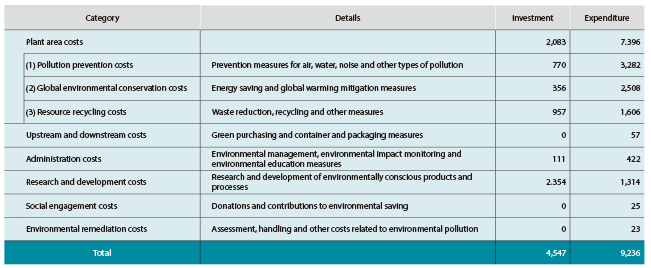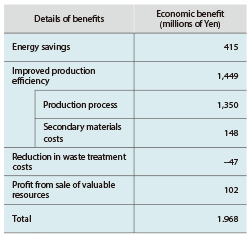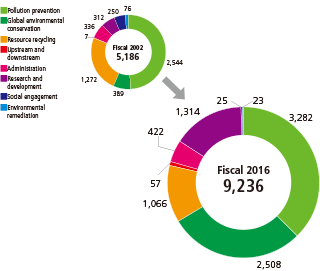PAGE NOT FOUND 404
URL: http://www.shinetsu.co.jp/en/csr/csr_manage.html
The Group works on Energy savings, waste and chemical substance management. We annually create the Shin-Etsu Group Environmental Safety Management Plan in accordance with the Responsible Care code and set goals using numerical numbers. The Company and all the Group companies set goals annually according to this plan and work on their activities.
In order to increase the level of activity, each plant and the Group companies perform several internal audits a year to check if their goals are appropriately set and the progress they have achieved. In addition, we check the activities and achievements plants have made also through periodical environmental control and safety audits.
The following are Targets and Results for environmental protection and chemical substance management for fiscal 2015 as well as Targets for fiscal 2016.
Shin-Etsu has continued to obtain ISO 14001 certification, the international standard for environmental management systems. In 1996, Shin-Etsu Chemical's Gunma Plant obtained ISO 14001 certification, becoming the first facility of a major chemical company in Japan to achieve such certification.
The Group constantly works so that manufacturing products will have the least influence on the environment. Furthermore, we do examinations so that our products will have the least environmental influence, which is also energy saving as well as resource saving. Research, Manufacturing and Sales divisions are united to develop such products. These well-examined products are used in various fields including industry, our daily lives as well as renewable energy.
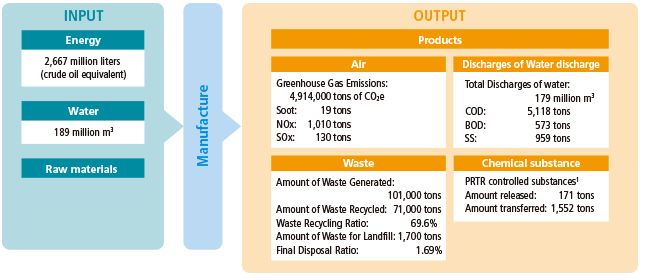
| Mid-term target | Reduce the greenhouse gas emissions to 45% of the 1990 level in emission intensity unit by 2025 |
|---|---|
| Results and evaluation | The Shin-Etsu Group was at 54.8%, and Shin-Etsu Chemical was at 51.7%, and they could not achieve the target |
| Fiscal 2016 target | Reduce energy consumption in intensity at an annualized rate of 1% |
|---|---|
| Fiscal 2016 results | The annualized reduction rate from fiscal 2013 to fiscal 2016 was 1.4% for Shin-Etsu Chemical. Shin-Etsu Group increased by 1.1%. |
| Fiscal 2016 evaluation | Shin-Etsu Chemical reduced 1% or more at an annualized rate and has achieved the target. |
| Fiscal 2017 target | Reduce energy consumption in intensity at an annualized rate of 1% |
The Group regards the global climate change as a critical issue to be resolved. Starting from fiscal year 2010, the Group promoted energy savings and installation of a cogeneration system in order to achieve the mid-term goal which is “Reduce the greenhouse gas emission intensity to 50% of the 1990 level in emission intensity by 2015”. Furthermore, in fiscal 2016, we set a new mid-term target of “reduce the greenhouse gas emissions intensity to 45% of the 1990 level in emission intensity by 2025”, and we have been working towards that goal.
Regarding the greenhouse gas emissions intensity for fiscal 2016, the Group and the Company achieved 54.8% and 51.7% of 1990 emissions respectively.
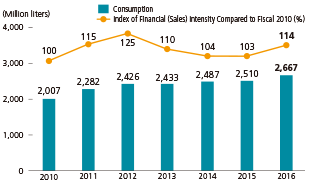
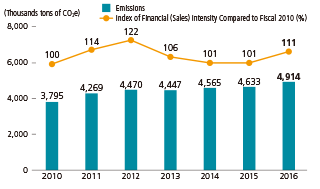

Each plant in Shin-Etsu Chemical is working on the recycling of heat energy.
Steam and electricity are produced in a plant using a cogeneration system1. Electricity made with the cogeneration system is supporting the operation of manufacturing facilities. In addition, steam is being used for heating and thermal insulation for manufacturing equipment. Steam used for heating will not be emitted but will be reused for manufacturing equipment in which steam with lower temperature can be used. The steam is finally changed into water to be collected to be used again.
Heat is recovered from the production process and is used as thermal energy in another process. Furthermore, the remaining waste heat is mainly collected as steam to make cold water in the absorption refrigerator. This chilled water is used for cooling the manufacturing equipment, etc.
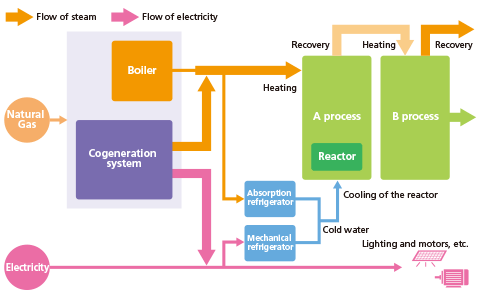
The Group’s Scope 3 greenhouse gas emissions for fiscal 2016 were 14,803 thousand tons of CO2, amounting to 75% in the supply chain1.
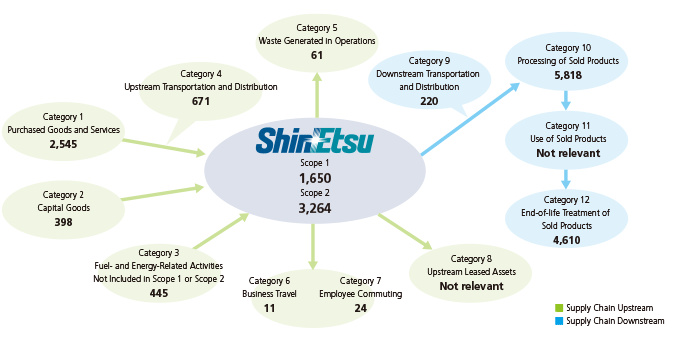
| Fiscal 2016 target | Achieve 1% reduction of water withdrawals in intensity at an annualized rate |
|---|---|
| Achieve 1% reduction of water pollutant discharge in intensity at an annualized rate | |
| Fiscal 2016 results | The annualized reduction rate from fiscal 2013 to fiscal 2016 was 3.8% in the water withdrawals amount and 8.5% in the BOD emissions amount |
| Fiscal 2016 evaluation | The annualized reduction rate was more than 1%, and the target was achieved |
| Fiscal 2017 target | Achieve 1% reduction of water withdrawals in intensity at an annualized rate |
| Achieve 1% reduction of water pollutant discharge in intensity at an annualized rate |
The Group’s major manufacturing plants are located where clean water is abundant. However, due to the scarcity of water in many regions of the world, the United Nations Environment Program (UNEP) has predicted that water scarcity in some regions will become serious by the year 2025. To enable the Group to continue to operate in those regions where there is a risk of water scarcity, we are actively engaged in conserving water resources by reducing our daily water withdrawals and recycling and utilizing water.
We also comply with regulations concerning water contaminants in emitting water so that the water we discharge will be of sufficient quality with sufficient values. We also check the water quality ourselves for verification.
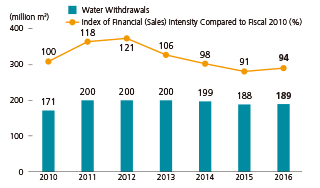
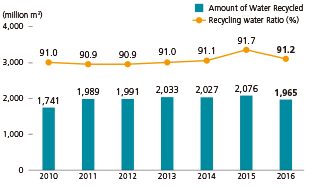
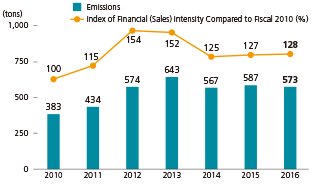
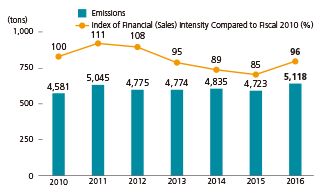
The Shin-Etsu Chemical Gunma Complex manufactures highly functional materials centered on silicone. Located inland in the south-west region of Gunma prefecture, the Complex draws its water required for manufacturing almost from nearby rivers and purifies the discharges of water from the Complex before return to the rivers.
The Gunma Complex is situated in a rich natural environment. Downstream from the nearby rivers sits the Tokyo metropolitan area where these rivers sustain the daily lives of its residents as well as industry and agriculture. Although the manufacturing of chemical products requires large quantities of water, the Complex strives to conserve valuable water resources by keeping its water withdrawals from these rivers to a minimum. For this reason, the Complex reuses as much water as possible in its manufacturing and water cooling processes by recycling and circulating water and ensuring there is no water leakage outside of the Complex.
Besides purifying the water before return to the rivers, rigorous water quality management is also applied. The Complex strives to maintain optimum conditions by continually monitoring the operating status of water treatment facilities and conducts regular water quality analysis of discharges of water to verify that it is in strict compliance with high water standards. Furthermore, they separate rainwater to prevent inflow of rainwater during heavy downpours as a measure to protect their treatment facilities from being damaged by natural disaster. In addition, since 2014 they have been carrying out seismic strengthening works assuming large-scale earthquakes.
By effectively utilizing limited water resources, the Gunma Complex will continue to fulfill its responsibility as an upstream located production base.
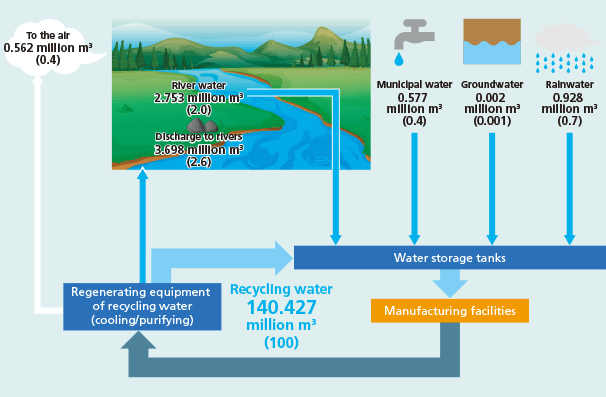
Calls are increasing for the protection of the world’s water resources, and since its foundation Asia Silicones Monomer Limited has been making effective use of the plentiful rainfall it enjoys in its location in Thailand.
It stores rainwater in storage tanks on-site, using it for industrial water and as coolant for waste gas incinerator. It always maintains a reserve of rainwater for use in fire fighting in the event of an emergency. It also supplies Group company Shin-Etsu Silicones Thailand and its nearby partners with rainwater for uses such as industrial water.
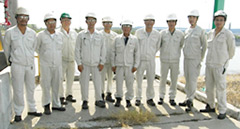
| Fiscal 2016 target | Achieve zero waste emissions (landfill waste 1% or less of the final amount of all waste generated) |
|---|---|
| Fiscal 2016 results | The final waste landfill disposal rate was 1.69% in the Shin-Etsu Group and 1.63% in Shin-Etsu Chemical |
| Fiscal 2016 evaluation | The target was not achieved |
| Fiscal 2017 target | Achieve zero waste emissions |
| Promotion of reduction of waste generation through intensity |
The production volume in fiscal 2016 increased compared to fiscal 2015, but the generated amount of waste and the amount of waste recycled remained almost unchanged with the amount of waste for landfills increasing by 5.0%. However, due to the characteristics of the manufacturing formula, a zero waste emission, which the Group aimed at, could not be achieved because there is a process where a certain amount of residue occurs. We will continue to work on fewer emissions and less waste for landfills.
We have external contractors to handle our disposals. We check to confirm that the contractor properly handles disposals by regularly inspecting the site, etc.
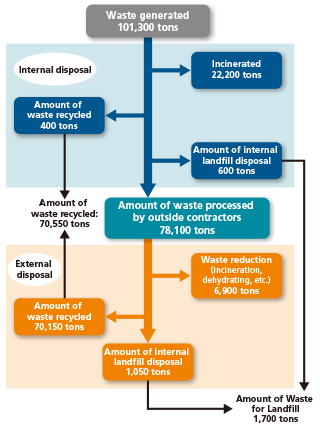
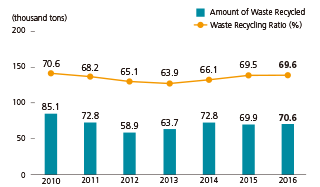
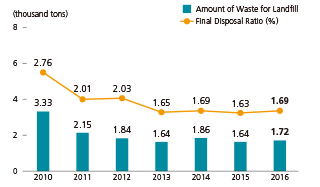
Drew Harris
General Manager - Production
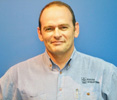
As an environmental initiative, Simcoa in Australia, manufactures and sells silicon metal, is committed to waste utilization. The waste utilization not only reduces environmental impact but also results in waste materials becoming a valuable resource by treating them as a by-product, and as such, the company is positively working towards reuse.
Charcoal is one example of a way in which waste materials are urilized. Wood from forest clearing for a bauxite mining operation is processed to produce charcoal. Previously, all the wood from the forest clearing operations was burnt, however, in 2004 the company began producing charcoal with the goal of effectively using the resource as a by-product.
Currently, Simcoa uses 100,000 tons of wood to produce 25,000 tons of charcoal each year. The source for the wood is felled trees from the bauxite mining operation, plantation wood, waste from sawmill and so on. No native forest trees are cut down to supply us with wood for charcoal.
Other examples of waste utilization in addition to charcoal are listed below. We hope these example initiatives help to demonstrate our commitment to the environment and waste utilization.
| Silica fume | Amorphous silica fume is a by-product of silicon metal. Initially when Simcoa began operations, there was no market for silica fume and the waste had to be buried in an on-site landfill. Simcoa developed a market in Australia for silica fume as an additive to increase the strength of cement, and has sold all of its silica fume for the past 20 years. |
|---|---|
| Charcoal fines | Fine charcoal is screened off from the lump charcoal because it cannot be used in the silicon metal furnaces and is sold for the production of barbecue briquettes. |
| Dross | A certain amount of slag1 is generated as a by-product during the manufacturing process of silicon metal. Slag is treated as a waste product by most silicon smelters, however, Simcoa sells this slag as a resource for producers of silicon manganese. |
| Sawdust and wood mulch | Sawdust and wood mulch are generated during cutting timber. It is sold for use in soil improvement. Investigations are underway into the potential use of this by-product for biomass energy generation in the future. |
| Undersized quaitz | As some of the quartz rock recovered from the quartz mine is too small for use in the silicon metal furnaces, it is sold as flux materials for use in metallurgical operations and as decorative stone for use with concrete. |
The Group collaborates with customers and related industry groups, using cutting-edge technologies to recover used products, extract resources, and reuse them in the Group's products. Through these initiatives, it is possible to reduce the waste output of our customers and the Group itself. We are also contributing to environmental conservation through reuse of resources.
The Group manufactures rare earth magnets by our integrated production process using separation and refinement techniques to extract rare earth magnets from rare earth raw materials.
As one of the measures to achieve stable procurement of raw materials, since 2007, the Group has been recycling magnet powder generated by our rare ear th magnet manufacturing processes.
Furthermore, from March 2013, we have also been developing techniques for recycling rare earth magnets used in recovered power-saving air conditioners and hybrid cars in order to re-use resources.
These initiatives have made it possible to reduce the environmental impact that comes along with resource development and to safely and securely protect the valuable rare earth resource. The Group's rare earth magnets create significant economic and social value as recycled products and also contribute significantly to energy conservation.
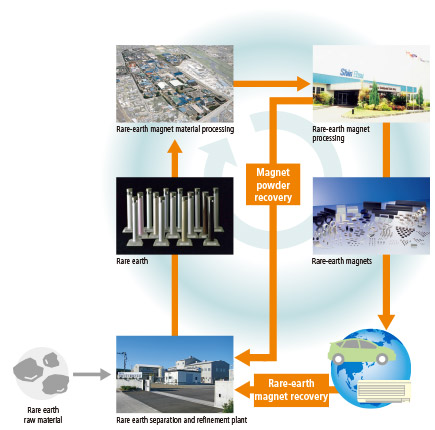
Initiatives for the recycling of products containing PVC are making progress. There are various methods for recycling PVC, the most common of which is material recycling. Material recycling uses used PVC products as raw materials to create new PVC products. PVC pipes, flooring materials and other PVC products are not greatly influenced by foreign substance contamination, so various kinds of recycling are conducted for those products. In particular, 60% of used PVC pipes and joints are recycled for reuse in new PVC pipes and joints, and 70% of agricultural film is recycled for use in flooring material.
The Group aims for environmentally considerate product design starting already from the product development stage. At the same time, we are also meeting our responsibility as a chemical company by working actively to ensure strict control of chemical substances, mitigate global warming, reduce energy consumption, reduce the amount of waste generated, prevent water pollution, and make other environmental contributions. We are also engaged in activities such as tree planting in our plant site in compliance with the Factory Location Act (Japanese law) and voluntary river cleaning in areas neighboring our plants. Furthermore, we request that our business partners implement environmental conservation initiatives concerning forest conservation and similar activities.
The Group preserves the earth’s ecosystem through these efforts.
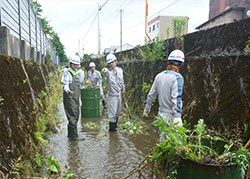
Nearby river cleanup effort (Shin-Etsu Chemical Takefu Plant)
We have bought pulp derived from wood as the main raw material of cellulose derivatives in the Group. Upon purchase, we ask all our pulp purchase partners to consider conservation of biodiversity, and we have confirmed that they all have obtained national and/or international forest certifications. In addition, we work hard to know about our partners’ activities on biodiversity activities.
The Group has chemical substances which requires strict release management. The Group works on reducing chemical release with proper manufacturing processes as well as establishing the proper operation conditions of pollutant treatment facilities. In addition, the Group reports the amount of chemical substance released and moved in natural environment according to the PRTR system1 in the PRTR Law2. The main factor in the increase of chloroethylene release is the increase in the number of work days at the PVC plant. On the other hand, release amount per consumption has declined by 5.2% compared with fiscal 2014 due to the production equipment running at optimal conditions.
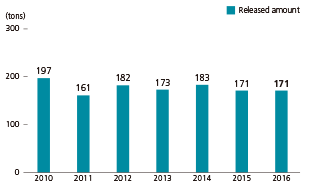
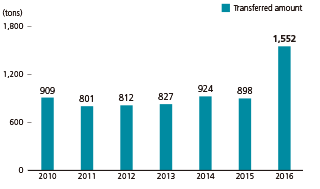
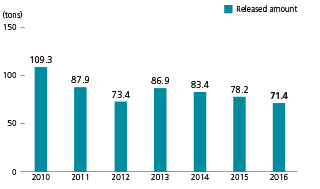
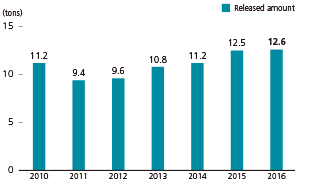
The Group is working to reduce emissions of air pollutants by setting emission reduction targets at each of our Group companies and by converting to fuel components with less sulfur. Each group company carried out regular investigations on emitted gas to confirm compliance with laws and regulations.
In fiscal 2016, soot emissions, NOx and SOx emissions decreased despite of an increase in production.
The manufacturing processes used by the Shin-Etsu Group do not discharge waste water or waste gas byproducts as-is into the atmosphere or rivers, instead extracting substances which can be used as fuel or raw materials, thoroughly recycling them and rendering them harmless before eliminating them. Below are some examples.
The cellulose derivative manufacturing processes of the Shin-Etsu Chemical Naoetsu Plant use caustic soda to process pulp created from trees. The result then undergoes reactions with chemicals such as methyl chloride to produce cellulose derivative products.
The waste gasses created by this process contain environmental pollutants such as VOC and PRTR controlled substances. The processes also create water with a high concentration of salt. These waste products are incinerated, producing a gas consisting of carbon dioxide and water vapor. The waste water is highly concentrated salt water, which is used as a raw material in electrolysis process.
This manufacturing process also creates water with high BOD values, containing organic compounds. This waste water is treated by anaerobic water treatment equipment1, separating most of the organic compounds in the waste water into methane gas and carbon dioxide. The methane gas is then used as fuel for the plant's boilers. The amount of methane gas produced each year is equivalent to 3 million liters in crude oil equivalent, and accounts for 20% to 30% of the fuel used by the boilers.
The waste water discharged from the anaerobic water treatment equipment contains some undecomposed organic compounds, so it undergoes additional treatment using aerobic water treatment equipment2, purifying it to BOD levels below discharge reguratory standard levels before discharging it.
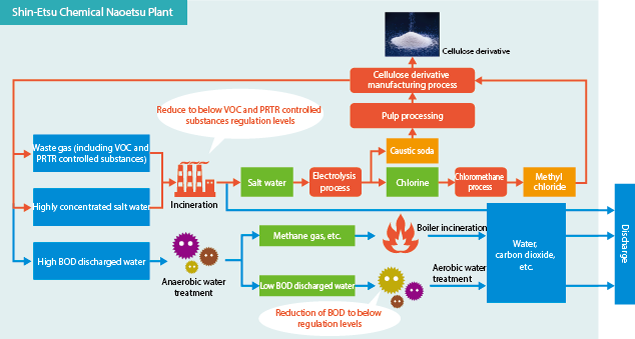
Groundwater and soil monitoring at each plant is being carried out in accordance with the Soil Contamination Countermeasures Act, and we make sure that we are in compliance with laws and regulations.
In fiscal 2015, the Company referring calculated to the Environmental Accounting Guidelines 2005 prepared by the Ministry of the Environment in Japan calculated the investments and expenditures involved in the reduction of the environmental impact of air pollution, water pollution, environmental release of chemical substances, etc.; energy-saving measures to conserve the global environment; and waste reduction and recycling to improve reuse of resources.
